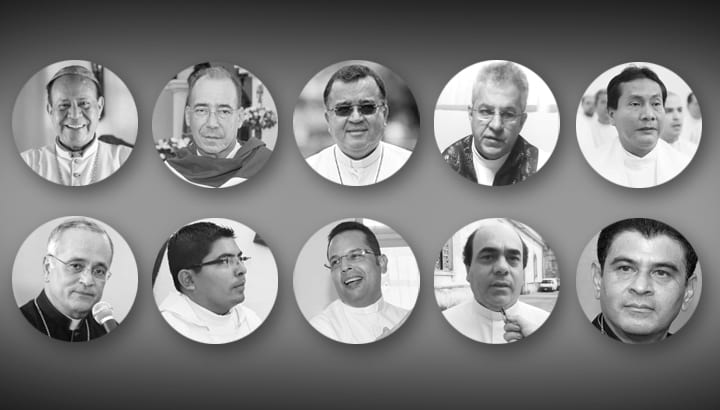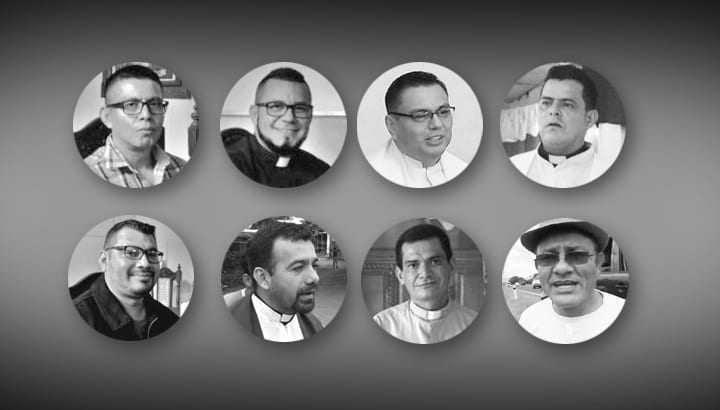Thirty Documented Aggressions against the Catholic Church in Nicaragua
Tuesday July 9th, marked a year since the Ortega-inspired mobs attacked the bishops in Diriamba’s San Sebastian Basilica. Since June 2018, the Ortega regime has attacked, besieged and threatened individual priests who have aided or sympathized with the protesters.
By Isela Baltodano (La Prensa)

HAVANA TIMES – “We want peace”, “Assassins!” “Sell-outs!” These were the words with which a mob of sympathizers with the Sandinista Front attacked a delegation from the Managua Archdioceses. The religious figures had arrived at the San Sebastian Basilica in Diriamba to protect a group of citizens who had taken shelter in the church on July 9, 2018. The Ortega fanatics laid siege to them in the church.
The mob not only launched insults, but there was also physical aggression. Monsignor Silvio Baez’ arm was cut and he received a blow to the stomach, while Miguel Mantica received scratches on the face and neck. Cardinal Leopoldo Brenes, Apostolic Nuncio Waldemar Stanislaw Sommertag and Masaya priest Edwin Roman were also struck.
The city of Diriamba, like the nearby towns of Dolores and Jinotepe, had been experiencing hours of terror. On the previous day, the Ortega regime had ordered Operation Clean-up to remove the roadblocks set up by protestors. This left at least 24 dead, according to reports from the Nicaraguan Center for Human Rights.
Since the protests began in April 2018 against the Ortega regime, the bishops and priests of Nicaragua have been supportive of the demonstrators, advocating for respect for their human rights, an end to the government’s aggression and persecution, and the liberation of the political prisoners. Medical attention for those injured in the protests was offered in a number of churches, while others acted as centers for collecting food for protestors. The priests’ support was looked upon very badly by the Ortega supporters, whose leader called them “Coup plotters”.
The priests have been attacked and threatened, and at least two have chosen to go into exile. The churches have been profaned, damaged and looted. The Nicaraguan newspaper La Prensa reviewed the incidents and counted at least 30 separate attacks on the Catholic Church over the last year.
18 priests attacked and threatened
Silvio Baez: He’s been called a “coup plotter” and a “Satanist”. He was directly attacked by mobs in Diriamba, threatened with death, and besieged by thugs on motorcycles at his home. In an attempt to disparage him, the Ortega regime distributed an audio clip supposedly linking him to a Coup, and asked Pope Francis to transfer him to another country. Despite the campaign waged against him for being critical of the regime, Baez assured that he’d continue in his religious ministry. In April of this year, Baez informed that he was being transferred to Rome at the request of Pope Francis. “I haven’t asked to leave. I’ve been called by the Holy Father,” he stated. In the same press conference where he announced his departure, he revealed that there had been a plan to kill him.
Miguel Mantica: Monsignor Miguel Mantica, from the San Francisco de Asis parish, had his face and neck scratched by protestors when he and other priests attempted to end the siege of the San Sebastian Basilica in Diriamba, and to free a group of people who were trapped there by the paramilitary.
Edwin Roman: The Ortega regime’s campaign of repression and harassment against Father Edwin Roman has lasted nearly a year. The priest had aided the protesters from his home, passing them buckets of water to wash their wounds. He had also gone out on the streets to call for the liberation of the political prisoners, while he continued attending to the faithful at his church in Masaya’s San Miguel parish. On one occasion, he was pushed and threatened by Ortega’s Masaya police chief Ramon Avellan; on another, he was pursued by motorcycles and the State-owned Hilux pick-ups. He was detained and beaten by police agents in Nindiri. On February 13, 2019, police officers stopped him near the road going into the Monimbo neighborhood. No blood or breath tests were conducted, but the police officer asserted that he was “in a state of inebriation.” His vehicle was impounded, and he was struck.
The latest aggression against Roman occurred on Wednesday, July 3, when he received death threats from three police agents, who told him that they’d give him “lead”. He was leaving the city of Masaya to visit family members when this verbal attack occurred. “They wish to offend, to harass. I wasn’t doing anything to them,” the priest later told La Prensa.
Pedro Mendez: Mendez, who presides over the Maria Magdalena parish in Monimbo, Masaya, was beaten by paramilitary in July 2018. This brutal attack occurred during “Operation Clean-up” which was directed by the Ortega police and paramilitaries from the city. Aside from injuring Father Mendez, the attack left a number of local residents dead and wounded.
Abelardo Mata: Bishop of the Esteli diocese, Monsignor Juan Abelardo Mata was attacked by mortars from the Ortega-allied mobs while he was visiting the area around Nindiri in Masaya in July 2018. The priest, who has been highly critical of the Ortega regime, was passing through a police checkpoint in the section by the roundabout when some men had him step out of his vehicle. At the time, Monsignor Mata was returning from officiating a funeral mass in Granada. He wasn’t wounded but had to take shelter in a nearby home due to the harassment directed against him for over an hour. The paramilitary shouted at him: “Judas!” “Coup plotter” and “Assassin!”
During a mass in the city of Esteli, Monsignor Mata denounced the presence of paramilitary inside the Catholic churches of the department and warned of the increase in death threats against Catholic priests.
Raul Zamora: This priest hasn’t been physically attacked, but on July 13, 2018, he experienced in his own flesh the attack of the paramilitary against the students who were occupying the National Autonomous University of Nicaragua in Managua. Zamora risked his own life by using his pick-up to transport young people who had been wounded by gunfire to his parish -Managua’s Jesus de la Divina Misericordia [Jesus of Divine Mercy]. The paramilitary subsequently attacked this church with gunfire, damaging the installations and the statue of the Divine Mercy. Scores of people, including journalists, were trapped in the church.
Rolando Alvarez: The bishop of the Matagalpa dioceses has also been the victim of threats and defamatory campaigns on social media. The Ortega allies accused him of storing “arms, medicine and food” in Matagalpa’s San Pedro Apostol Cathedral, for the demonstrators that were protesting against the regime in that city. He was also accused of sheltering “delinquents” in the city’s Catholic schools, including San Luis, Santa Teresita and San Jose, as well as in the Pastoral retreat center La Cartuja.
Last September, Alvarez was accused of being a “terrorist” and an “assassin” by Ortega sympathizers, who forced him to step out of the vehicle he was riding in. The harassment and attack were captured in a video that was uploaded to social media.

Jairo Pravia and Marlon Velasquez: These two priests were accused of forming part of “the MARA gangs’ command center” and of meeting in the Inmaculada Concepcion de Maria parish in the central Nicaraguan city of Sebaco to plan “how to smuggle out the criminals and arms being held in said church”.
The social media campaign to vilify them started when they intervened in favor of the release of Jarvin Urrutia, a citizen who was detained at a barricade raised by demonstrators protesting the Ortega-Murillo regime in June of last year.
Juan de Dios Garcia: This priest received death threats from Ortega fanatics for mediating during the demonstrations that citizens held in Carazo against the current regime. He was then transferred out of the church that he had presided over in Jinotepe.
Vicente Martinez Bermudez: In June 2018, the parish priest from the Santa Lucia Church in Dario was detained by a group of hooded men at kilometer 90 north of Managua, the main branch road to the city of Dario. One of the hooded figures pointed his AKA machine gun at the priest’s chest and threatened to kill him. “You’re the next victim. Go, but your days are numbered because you’re next,” the man told the priest, who responded that he wasn’t afraid of them.
Juan Antonio Calero: The parish priest of the San Juan de Dios Bautista church located in Masatepe, Carazo escaped an attempt to abduct him in June of 2018. The attempt was denounced via the parish’s Facebook page. According to the post: “Hooded subjects attacked the Villa Progreso neighborhood” with firearms. The priest managed to “make a rapid exit from the rectory and is safe and sound”.
Alfredo Garcia: Parish priest from Managua’s San Cristobal Church, Garcia was threatened by paramilitary in June 2018 according to information from the Managua Archdiocese. “We hold these groups responsible for any actions taken against our parish. We thank the community that remains watchful over our parish and we invite them to remain in constant prayer,” Garcia declared.
Edgar Cubillo, Alfonso Paisano and Heberto Lopez: These priests from the city of Boaco in central Nicaragua were accused of being “accomplices” in the death of FSLN sympathizer Gaston Palacios. The accusations were made over social media in June 2018 by leaders of several of the state institutions. Cubillo, who accompanied protesters in the city, was also accused of directing the roadblocks set up at the intersection to Boaco. The accusations of complicity were made because Paisano and Lopez made a visit to the jail in which the three citizens processed for the crime of setting up the roadblock were being held.
Augusto Gutierrez: Death threats and the possibility of jail time for supposedly financing terrorism led the priest from Masaya’s San Sebastian Church to go into exile. This was the first case of a priest who chose to leave the country due to the harassment, persecution and threats. During the struggle in Masaya’s Monombo neighborhood in 2018, Father Cesar Augusto Gutierrez aided the demonstrators with food and blessed the victims of the regime’s repression. “[They told me] that they were going to kill me, that they were going to ambush me, that they didn’t care if I was alone or accompanied, that I was in deep with the young people and that’s why they wanted to kill me,” the priest told La Prensa.
Gutierrez denied accusations that he had received money from narco-traffickers and “that I took that money and distributed it to the kids at the roadblocks.” He termed the accusation “totally false”.
Pedro Denis Obando: In June 2019, Father Pedro Denis Obando, from Esteli’s Cathedral left the country due to the death threats that he was receiving, principally from members of the paramilitary who were pressuring him to inform on the movements of Monsignor Mata, bishop of the Esteli dioceses. The latter helped Obando leave the country. Bishop Mata assured La Prensa by telephone that he was also under continuous harassment for denouncing the regime’s human rights violations.





